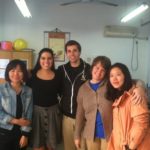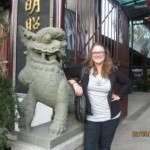Finding Community in Beijing

Strains of zither, fiddle, and flute drift through the cypress grove as I jog down the path. It is too early in the morning and too chilly in Beijing to be outdoors, but it is the only time I can get clean air into my lungs. I follow the refrain to discover a band of middle-aged women practicing tai chi in a clearing. A boombox ekes out the melody to which they perform. The ladies make balletic movements, raising their arms and hands to the sky, slowly lifting their legs. A few yards away two monks train at wing chun.
I watch the men’s choreographed stances until I am distracted by a flying shuttlecock landing in front of me. A boy in a knit cap comes to retrieve it and I tag along behind to where his father waits. They continue their badminton game, me their sole audience. After a round of volleys the father hands his racket to me. I trade shots with the kid for a while before lobbing the feathered cone too far. The son crows with delight and chases after it. I thank the man, return his racket, then continue on my run through the park.
Along the way I come across a throng of elders sitting along the railings of a vestibule. I assume they are waiting in line to enter the adjacent fifteenth century imperial complex. As I get closer, I notice all of their heads are bent in concentration. Some of them mutter, others slap their thighs in frustration. I pause and approach the crowd. They are clustered in groups of five or seven, and between each circle is a mahjong board. Tiles click in fierce precision, their tick-tock a metronome for the twittering birds.
We humans are social animals, reliant on neighbors, friends, and family to forge our civic duties, support our economic needs, and sustain our desire to be understood.
To escape the smog-ridden streets, I have been coming to the green acres around Temple of Heaven for my daily workout. Every morning on my circuit I pass by grandparents playing with their charges, school girls rehearsing dance routines, calisthenics clubs, and the mahjong congregation. It is not a peculiarity of this shrine. Arriving at the square in front of the drum tower, I cross paths with a youthful gang of jianzi players. Lost in the warren of back alleys, I ask directions from a troop of families enjoying their communal courtyard. Though much of Beijing is being rebuilt into car-friendly avenues and high-rises, locals are managing to carve out spaces where they gather for exercise, gossip, and fellowship.
We humans are social animals, reliant on neighbors, friends, and family to forge our civic duties, support our economic needs, and sustain our desire to be understood. Urban areas are ideally suited to providing such connections because they force close interactions. Most of the time, I do not consider municipalities as heralds of sociability. I think of them as rabbit burrows whose residents are strangers scurrying, shoulders hunched, furtive, and vexed by any inconvenience to their hurried routines. To me, many of these man-made jungles feel like prisons — devoid of free space, entrapping all who enter into a maze of unknowable dead ends.
I shuffle my way through their grubby tunnels, head down, eyes averted, wishing for nothing more than the competent machineries of modernity to spit me out at the appropriate terminus. I do not loiter in the expressionless plazas or rest upon the brooding park benches. I never stroll through the damp quadrangles, never linger beside boulevard buskers. I avoid both the frazzled herds and the bizarre vacant pockets that mutely entreat the unwary.
Gardens, playgrounds, and footpaths shape how we live somewhere quite differently than malls, gated enclosures, and highways.
In Beijing, however, I see the limited accessible surroundings transformed into spirited salons. It is in the details that these centers become personable: the shop keeper sweeping her bit of sidewalk, the two brothers walking unsupervised to school, the game of chess waiting to be played under the gingko tree, the geriatrics limbering up for morning aerobics at the market. In exploring these public spaces I am beginning to understand their importance in the civic scope of a metropolis. Gardens, playgrounds, and footpaths shape how we live somewhere quite differently than malls, gated enclosures, and highways. Efficiency and productivity are hallmarks of the ideal borough, but where does this leave its inhabitants? People complicate geography: they create imbalance, they produce disorder, they generate waste; they also invigorate a region with their ideas, their skills, and their passion. If our cities truly belong to us, they have to fulfill our need to form communities.
I may have come to the festivities too late. As public spaces vanish, replaced by commercial blocks and private neighborhoods, I am losing my chance to get to know the populous destinations to which I travel. Happily, Beijing is giving me an opportunity. On one of my morning laps through Tiantan Park I sneak into the back of a tai chi session in progress. I attempt the graceful gestures, an uncoordinated lurching newcomer. I sample teas in a Shichahai hutong while three entrepreneurial bartenders try to teach me how to play a Chinese game. I fail to win, yet do learn how to hand count in Chinese. I stop to listen to an impromptu choir in Jingshan Garden. After accomplishing their initial number, the singers magically supply a chair so I will stay for the rest of their show. Slowly, the citizens of Beijing are teaching me to rediscover their home through engagement with their public spaces.








